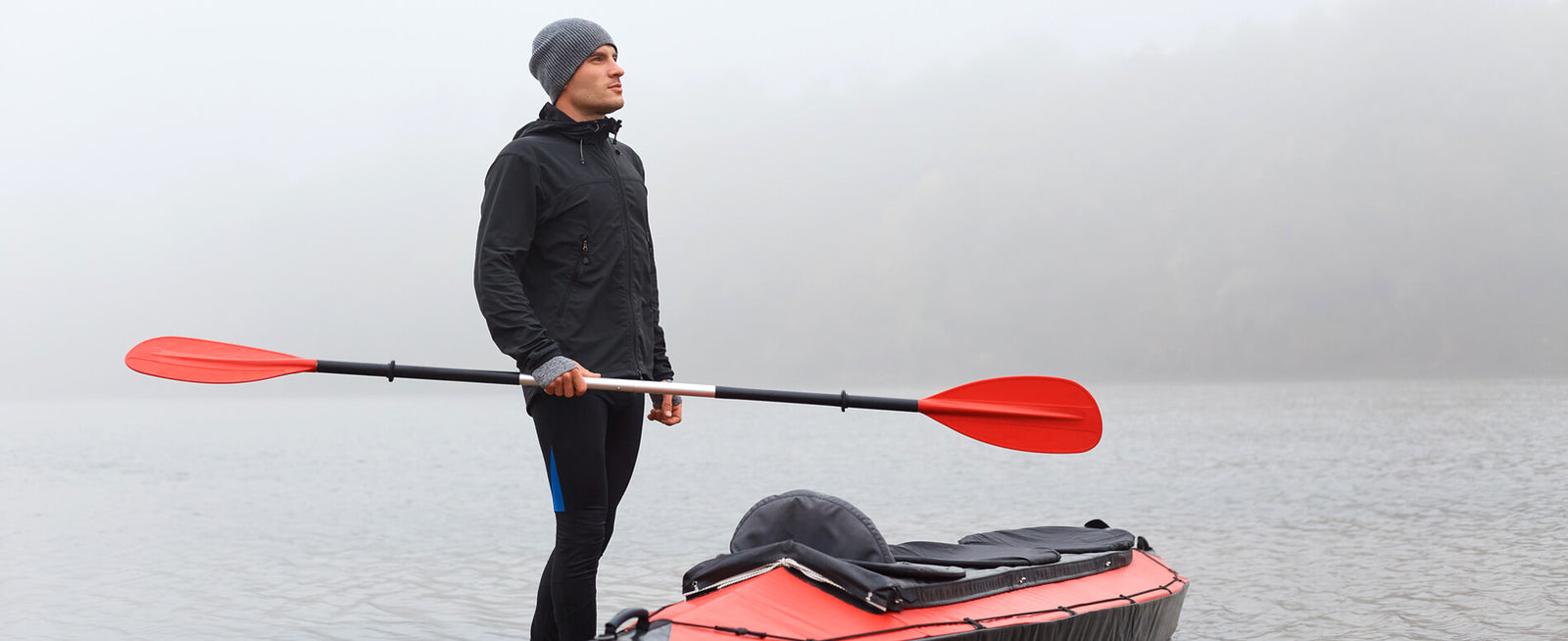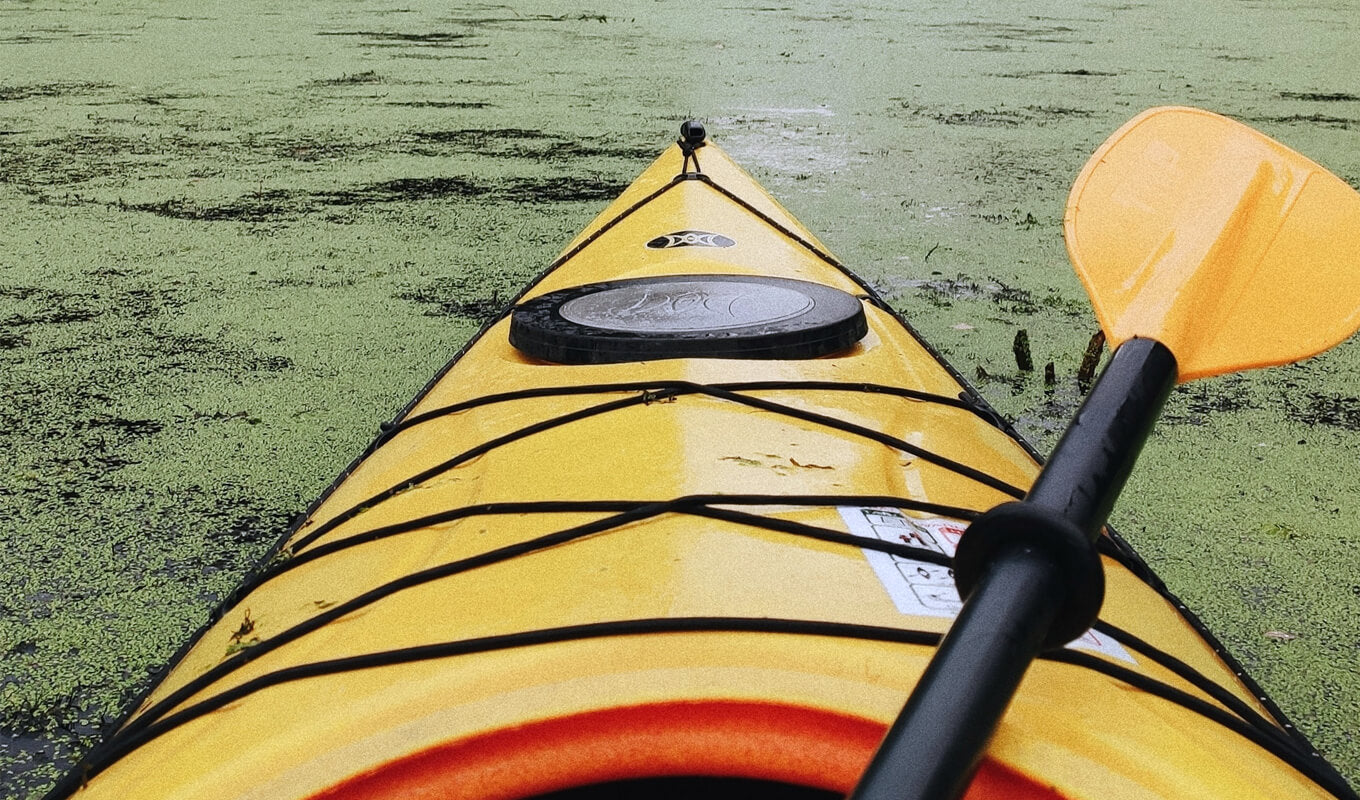Your Cart is Empty


Kayaking has been around for centuries and as modern technology develops, so does all the gear and equipment available on the market. And of course, this is no exception for kayak paddles.
Understanding the world of kayak paddles may seem simple, but there are actually many components and factors that come into choosing the perfect kayak paddle.
Whether you’re brand new to kayaking, or if your new kayak came with a standard low-quality paddle that you’re looking to upgrade, we’re here to help you size and choose the best kayak paddle for you and all your paddling needs. Let’s get into it!
As the whole point of kayaking is to paddle, it’s no surprise that your kayak paddle can make a huge difference in terms of comfort, usability, and control.
Comfort is key. Especially when you’re paddling over long distances. So, if your paddle is too short, for example, you could end up having to lean into the water with every stroke. This repetitive leaning movement could injure your back and make your time on the water miserable.
On the other hand, if your paddle is too long, it could be difficult to lift and move through the water. So, either way, sizing your paddle correctly will make a world of difference.
The navigation and turning of your kayak also comes down to your paddle. If you aren’t able to use your paddle efficiently and correctly, then moving through the water would be difficult and energy-consuming. And, it goes without saying that using up all your energy too quickly will result in you having to cut your kayaking journey short.
Finally, kayak paddles are designed with experience levels in mind. There are paddles for beginners and paddles for highly experienced boaters and deep-sea kayakers. What works well for one activity or skill level doesn’t always work well for others, so it’s important to keep that in mind.
One of the most important things to take into consideration is the paddle length. Luckily, however, choosing a paddle length is relatively straightforward.
Picking the right kayak paddle length combines two separate factors: how wide your boat is and how tall you are. Wider boats or taller paddlers need longer paddles. Narrower boats or shorter paddlers need shorter paddles. It really is as simple as that.
Different paddle brands will have a slight difference in their kayak paddle sizing so it’s important to always double-check their size charts before purchasing a paddle. But as a general rule, you can follow the kayak paddle size chart below.
| Paddle Height | Boat Width | |||
| Under 23" | 23" to 28" | 28" to 32" | Over 32" | |
| Under 5' tall | 210 cm | 220 cm | 230 cm | 240 cm |
| 5' to 5'6" tall | 215 cm | 220 cm | 230 cm | 240 cm |
| 5'6" to 6' tall | 220 cm | 220 cm | 230 cm | 250 cm |
| Over 6' tall | 220 cm | 230 cm | 240 cm | 250 cm |

The next thing to look into when choosing a kayak paddle is the shaft material. Kayak paddles come in a range of shaft options, from the cheaper aluminum shafts all the way up to the more premium carbon fiber shafts.
Aluminum paddles are usually the standard paddles that’ll come in most kayak sets. They’re budget-friendly and durable, which makes them a great option for kayak rental companies as they’re easy to replace if they get damaged.
Their downfall is that they’re heavy. Using a heavy paddle to kayak will tire you out far quicker than a more premium lighter paddle. But you have to start somewhere, and if your budget only stretches as far as an aluminum paddle, then it’ll work just fine. You can always upgrade in the future.
A step up from an aluminum shaft is a fiberglass shaft. Fiberglass shafts are lighter, stronger, and perform better than a standard aluminum paddle. With a higher level of performance, however, comes a slightly higher price tag.
The last type of paddle shaft is a carbon fiber shaft. These paddle shafts are the most premium of all, and this is highly reflected in their performance.
If you spend a lot of time paddling, then paying the extra money for a carbon fiber shaft is well worth it. Their lightweight design makes it incredibly easy for you to propel yourself through the water and save much needed energy.
The paddle blade also plays a huge factor in the paddles overall performance, but we’ll get into that a little bit later.
As well as the material your paddle shaft is made from, you also need to think about its design.
Paddle shafts come in a bent or straight shaft design, with the bent shaft paddles having a kinked section in the center. This kinked section in a shaft gives the paddler a more comfortable angle to power their stroke into. This angle ultimately minimizes discomfort and fatigue while paddling.
Shafts also come in a two piece or four piece design and were created to be broken down for easier storage. If you have an inflatable kayak and plan on taking it overseas or simply on a hike with you, then the four piece shaft design will work in your favor as it can be broken down into smaller more manageable pieces.
Finally, shafts come in a standard or small diameter size. If you aren’t able to touch your thumb to your index finger while holding the paddle, then you’d need to opt for a small diameter shaft.

Not only should you consider the materials of your paddle shaft, but you also need to think about the materials of your paddle blade. Paddle blades, like paddle shafts, come in a range of different materials, with more affordable and premium options available.
The most affordable blade option on the market is a plastic or nylon blade. These blades are incredibly durable thanks to their flexibility in the water. But, although flexible sounds great because who wants a cracked paddle? (a cracked paddle is still possible with a plastic blade, however) This flexibility lacks efficiency in the water.
Plastic blades are great for beginners though who are just starting out paddling and aren’t too worried about performance.
A fiberglass blade will typically come in at the middle of the price range similarly to a fiberglass shaft. As fiberglass is more lightweight than plastic they enhance the paddler’s performance and require less energy to lift them out and glide them through the water.
The blade material that comes out on top, however, is a carbon fiber blade. Carbon fiber is the lightest of all blade materials and truly makes paddling a breeze. Of course, with this high performance comes a high price tag, but it’s totally worth it and you’ll definitely see a difference out on the water.

Now that you’ve chosen your blade material, you’ll need to decide on a blade shape.
It’s important to note that blades can come in a feathered or matched variation. Matched paddle blades are aligned with each other meaning they’re both facing the same way at the exact same angle.
A feathered paddle blade, however, has an offset between the two blades. This offset helps to reduce wind resistance when the blade is out of the water. Most paddle shafts come with a feature so you can rotate the blades to be in a feathered or matched position to suit you and your paddling style.
Many modern paddles have an asymmetrical dihedral shape. Asymmetrical blades are narrower than most other blades and are shorter along one side.
As kayak paddles typically strike the water at a shallow angle, an asymmetric blade allows the blade to be lowered deeper in the water. With more depth comes more power and even increases overall maneuverability.
A dihedral blade has a distinctive rib down its center that allows water to flow evenly over both halves of the paddle blade. Dihedral blades work well when tracking is important as the water is evenly distributed over the blade's surface area.
Narrow blades come in handy when paddling over long distances. Thanks to their narrow design, these blades are more lightweight than other types of blades making them better for full-day kayaking or even multi-day adventures.
If you’re after a blade that’ll propel you through the water fairly quickly, then you’ll want to be purchasing a wide one. The larger surface area of a wide blade will give you far more power when gliding it through the water as opposed to a narrow blade.

The purpose of your paddle will also play into which type of paddle blade you’ll want to purchase. There are two variations: a high angle paddle, and a low angle paddle.
High angle paddles were designed to be held vertically during a forward stroke. This vertical positioning allows the stroke to be more powerful and pushes the paddler through the water at higher speeds.
Paddles of the high angle type are excellent for racing or whitewater paddling as their blades are wider and shorter giving the paddler more control in the water.
A low angle paddle on the other hand was designed to be held horizontally with the paddler's hands closer together during the stroke. Low angle blades are narrower and longer making them perfect for touring or flatwater paddling.
When it comes to performance the best type of kayak paddle is a combination of a carbon fiber shaft and a carbon fiber blade.
The lightweight design and materials of these paddles make them extremely easy to glide through the water. This ease of use helps to conserve the paddler's energy and allows them to paddle over much farther distances than a standard paddle.
The length of your kayak paddle will come down to the width of your kayak and your height. If you have a wider kayak, then you’ll need a longer paddle so it can reach the water on both sides.
The same goes for if you’re on the taller end of the height scale. If you’re taller and have a longer torso your paddle stroke will be from a higher starting point than shorter paddlers. This higher start point will require additional length so your paddle blade can fully enter the water with each stroke.
Luckily paddles come in a range of sizes including those for kids! Sizing kayak paddles would work in the same way for children as it would for adults. Their height and the width of their boat will determine how long their paddle needs to be.
A great way to prevent the loss of a paddle in the water is a paddle leash. A paddle leash wraps around your paddle and then connects to one of your kayak tie down points like a D-ring or bungee cord.
It is similar to what surfers use to prevent their surfboards from floating away, just in a paddle form.
Comments will be approved before showing up.